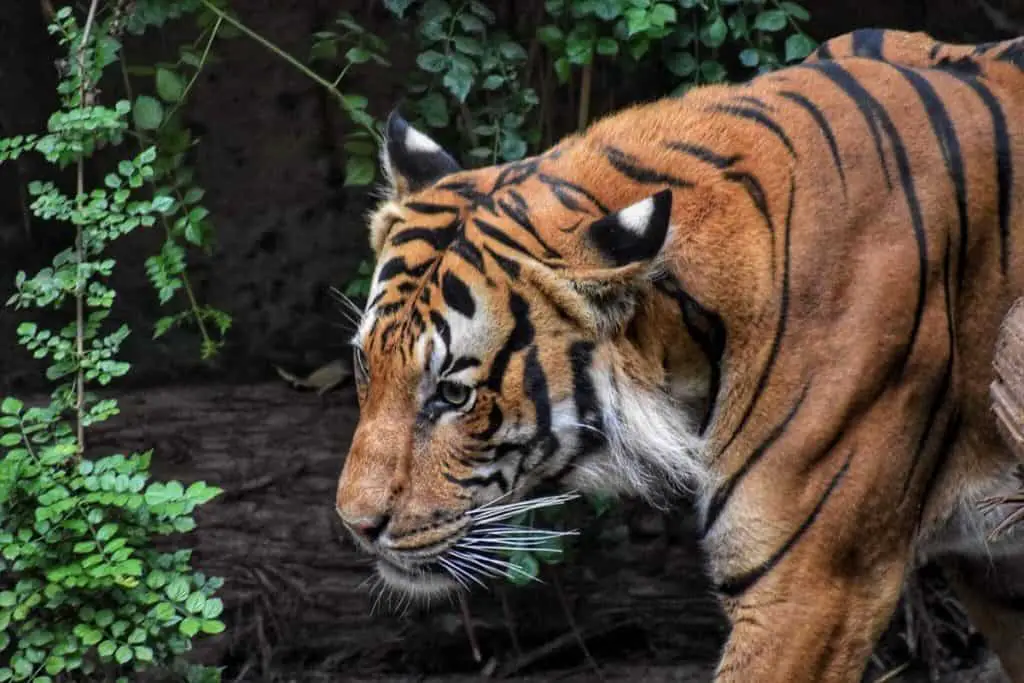
There are many animals out there that can be very dangerous animals.
But what about tigers?
Are tigers dangerous animals or aren’t they?
In this article, you’ll find the exact answer to this question and I’ll also cover a few more closely related questions as well after you’ve read the answer to the main question which might be of interest to you as well.
I hope you learn a lot from this one!
Are tigers dangerous animals?
Tigers are, generally, very dangerous animals.
Tigers, or Panthera tigris, are the largest of the cat species.
They can range from six to ten feet in length and weigh anywhere between 220 and 660 pounds (WWF).
Tigers are apex ambush predators that engage in solitary nocturnal hunting.
They chiefly prey on deer, boar, and other mammals.
Owing to their size, weight, and strength, they are extraordinarily dangerous.
In the wild, tigers tend to avoid human beings, but they will defend themselves, their cubs, and their territory with force.
Are white tigers dangerous?
White tigers are Bengal tigers that result from selective breeding in captivity.
The first white tiger was captured in India in the early 1950s and all subsequent white tigers have been derived through the inbreeding of their offspring.
Like all tigers, white tigers are extraordinarily dangerous.
Some people assume that since white tigers are raised in captivity that their predator instinct is suppressed.
There is no scientific evidence to suggest that this is the case, and researchers who have studied the behavior of white tigers have concluded that they retain their predatory ambush capacities even when they’re raised in captivity.
Are Bengal tigers dangerous?
Bengal tigers can be very dangerous.
They are one of the two remaining subspecies of tigers in the world, the other being the Sumatran tiger.
By comparison to the Sumatran tiger, which is the smallest of the subspecies (on average, 8 feet long and weighing around 260 pounds), mature Bengal tigers are much larger as they are, on average, over 500 pounds in weight and almost 10 feet in length.
While all tigers are dangerous, the size, weight, and strength of Bengal tigers make them an extraordinarily dangerous tiger species.
Are Tasmanian tigers dangerous?
Tasmanian tigers, or Thylacinus cynocephalus, are not in the cat, or Felidae family.
Rather, they were nocturnal marsupials that looked a bit like a wolf with tiger stripes.
While there have been alleged sightings in the wild, these have not been confirmed or substantiated, so in the 1980s they were declared an extinct species.
Before their extinction, Tasmanian tigers were considered dangerous, however, it is not clear whether they ever posed a threat to human beings, aside from the economic impact that may have resulted from them preying on domesticated livestock.
Scientists tend to describe them as having been rather shy and skittish, and it seems they often avoided human contact.
Despite this knowledge, we can conclude that they might have been dangerous since they were predators and had unusually large jaws.
Are Siberian tigers dangerous?
Siberian tigers (as well as Bengal tigers) are a population of the continental tiger.
By comparison to the Sumatran tiger, which is the smallest of the subspecies (on average, 8 feet long and around 260 pounds in weight), mature Siberian tigers are much larger, they are, on average, over 500 pounds in weight and almost 10 feet in length.
While all tigers are dangerous, the size, weight, and strength of Siberian tigers make them a lot more dangerous than many other tiger species.
Are saber tooth tigers dangerous?
Saber tooth tigers, or Smilodon populator, are an extinct species, but if they still existed, they would be very dangerous.
Like extant tigers, Smilodon populators were members of the cat family.
Their name derives from the large, sharp canine teeth, which sometimes grew to seven inches or more.
This allowed them to easily slice through flesh.
Like present-day tigers, the saber tooth tiger was an apex predator and it is believed that they went extinct as a result of being hunted by humans.
Which tiger species is the most dangerous?
While all tigers are dangerous, the size, weight, and strength of continental tigers namely, Bengal and Siberian tigers make them the most dangerous.
Also, both Siberian and Bengal tigers are apex predators that engage in solitary nocturnal hunting.
So, you can be sure that running into a group of Siberian or Bengal tigers isn’t a common phenomanon.

Are baby tigers dangerous?
After only 12 weeks of age, a baby tiger is capable of inflicting severe wounds on a human.
By six months they can easily be lethal.
So, it can be said that baby tigers can be dangerous but you can also be sure that they won’t be able to do much damage when they’re under 12 weeks old.
Are tiger cubs dangerous?
After only a couple of months, a tiger cub is capable of inflicting severe wounds on a human, and by six months they can easily be lethal.
So, it can be said that tiger cubs can be dangerous animals.
Also, typically, a tiger will grow to approximately a third of its mature height and weight after only 12 months.
Are tigers dangerous animals to humans?
Tigers can be very dangerous to humans.
In the wild, they tend to avoid human beings, but they will defend themselves, their cubs, and their territory with force.
They are apex ambush predators that engage in solitary nocturnal hunting, and they tend to hunt deer and boar.
Although tigers do not hunt humans, they surpass us in size, weight, and strength and are thus very dangerous, especially when threatened.
Check out the video below if you want to find out how you can survive a tiger attack.
Are tigers dangerous animals as pets?
They are dangerous pets, even when they’re young.
Tigers are apex predators and they retain their predatory ambush capacities even after decades in captivity.
They are also territorial, and they will respond violently to a perceived threat to either themselves, their cubs, or their territory.
Should you keep a tiger as a pet?
It is best to not keep a tiger as a pet.
For example, a full-grown Sumatran tiger is quite large: on average, 8 feet long and 260 pounds in weight.
And Bengal tigers are even larger, averaging 500 pounds in weight and almost 10 feet in length.
They can consume over 20 pounds of meat per day and they require large and well-designed enclosures.
Hence, it is extraordinarily expensive to properly feed and provide good shelter for a tiger.
Finally, they are very dangerous.
They are territorial, and they will respond violently to a perceived threat to either themselves, their cubs, or their territory.
Also, after only a couple of months, a baby tiger is capable of inflicting severe wounds on a human.
For all of these reasons, it is unwise, impractical, and dangerous to keep a tiger as a pet, regardless of its age.
Certain families, however, still choose to keep tigers as pets because they are willing to take the risk.
Check out the video below if you want to see a family that enjoys keeping tigers as pets.
Why are tigers dangerous animals?
Tigers are apex predators and they retain their predatory instincts even when raised in captivity.
They are the largest of the big cat species, ranging from six to ten feet in length and weighing anywhere between 220 and 660 pounds, and they are very strong.
In the wild, they are ambush predators that engage in solitary nocturnal hunting whilst using their jaws and sharp teeth to break the necks of their prey and their claws to tear through flesh.
Also, they are very territorial, and they will respond violently to a perceived threat to either themselves, their cubs, or their territory.
Why is a wounded tiger dangerous?
When an animal is injured, it is aware that it is vulnerable to an attack or opportunistic predation.
This is true even in the case of apex predators like tigers.
Even when a tiger is not injured, it will respond violently to a perceived threat to itself, its cubs, or its territory.
When injured, this instinct is acutely heightened as a self-defense mechanism.
Even if a person is attempting to render aid to an injured tiger then the tiger may perceive this as a threat.
Do tigers attack humans?
Tigers will attack humans when they feel threatened or whenever they’re after our meat.
However, they typically attack humans only when they feel threatened or when they have not had access to other food sources.
Also, they typically do not hunt humans for their meat as they’d rather instead hunt deer, boar, or other animals.
Even if you do not pose a threat to a tiger, it may perceive you to be one depending on the situation.
So, it is always best to evade tigers whenever possible.

Do tigers eat humans?
Tigers will eat a wide variety of animals, but they tend to prefer large-bodied prey such as deer, boar, and horses.
Fortunately, they do not exhibit any particular desire to eat human meat but if they have been starved and lack other options then they might attack humans and eat human meat.
However, this remains aberrant behavior.
Is a tiger more dangerous than a lion?
Tigers are more dangerous than lions.
While lions and tigers have similar body proportions, tigers tend to be 100 to 200 pounds heavier because of their muscles.
Tigers are also solitary, so they have evolved to fight threats on their own, whereas lions are pack animals and have evolved to rely on other members of their pride when confronting threats.
Conclusion
In this article, you’ve learned that tigers will, generally, be dangerous animals.
Tigers are solitary animals which means that they need their knowledge and strength to survive difficult situations which also means that they know how to take care of perceived threats.
Also, tigers often prey on deer, boar, and various other mammals as tigers are carnivores which also means that they won’t back down from a fight with a human.

